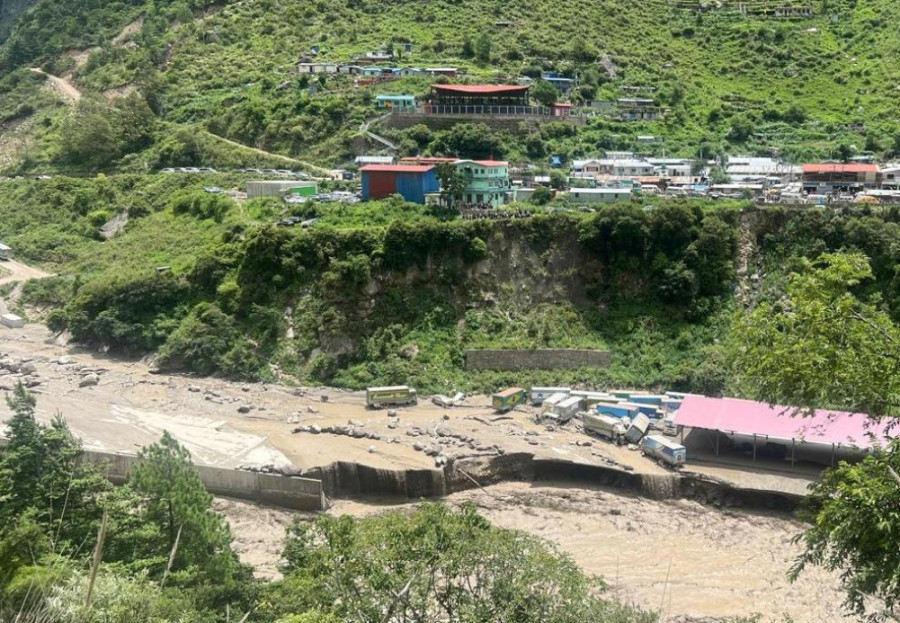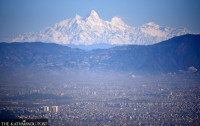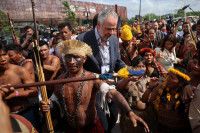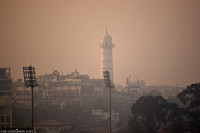Climate & Environment
Rasuwagadhi flooding exposes gaps in neighbourly data-sharing
At least eight died, 19 are missing in Tuesday morning flooding of Bhotekoshi river in Rasuwa.
Arjun Poudel
Officials at the Flood Forecasting Division under the Department of Hydrology and Meteorology were unaware of the flood in the Bhotekoshi river until 6 o’clock on Tuesday morning. This lack of knowledge caused deaths and widespread devastation in the Trishuli river basin.
They knew about the flood only when it reached Betrawati, the border between Rasuwa and Nuwakot districts.
“After we knew of the incident, we sent mass SMS to people of affected areas urging them to take precaution,” said Binod Parajuli, senior divisional hydrologist. “We didn’t get any warning of a flood in advance from China, as there is no such mechanism in place.”
The deadly flood has once again exposed Nepal’s vulnerability to cross-border climate events and the urgent need for real-time data-sharing with neighbouring countries to prevent such disasters.
The flood, however, had already caused widespread devastation before the warning message reached people’s phone sets.
At least eight people have died and 19 have gone missing (11 Nepali nationals, including two police and six Chinese nationals) in the flood, according to Nepal Police. The flood also swept away the Friendship Bridge, which connected Nepal with Tibet. Several hydropower projects constructed on the Trishuli River suffered severe damage, disrupting power generation.
A dry port being constructed at the Rasuwagadhi border point sustained severe damage, and multiple container trucks and electric vehicles parked at the customs point were swept away in the flood. Fifty-five people rescued including 25 by Army choppers stranded in the middle of the Trishuli River and the hydropower dam. Among the rescued people, four are Indian nationals while one is a Chinese national.
Kaisang Narpu Tamang, chairman of Gosainkunda Rural Municipality of Rasuwa, said floods swept roads to Rashuwagadhi at multiple locations. He said a glacial lake outburst on the Chinese side could have triggered a flood in the Bhotekoshi river.
“It is hard to predict how long it will take to rebuild the road,” Lama told the Post over the phone from Dhunche, Rasuwa. “The connection with China through Rasuwagadhi has been completely cut off.”
Officials at the department’s Meteorological Forecasting Division and Flood Forecasting Division said there was no sign of heavy rainfall on the Nepal side of the border, and they don’t know what is happening on the Chinese side, as the country does not have a mechanism to share rainfall and flood water data.
“We still do not know what triggered the flood in the Bhotekoshi River,” said Shanti Kandel, a senior meteorologist. “Heavy rainfall in Tibet, a river blocked by landslide or a glacial lake outburst—any one of these could have triggered the flood. A detailed study is needed to ascertain the real cause, which calls for cooperation between Nepal and China.”
The Met Office said it doesn’t have a rainfall gauging station in the Rasuwagadhi area, and the nearby stations in Dhunche and Kyanjin show only scant precipitation.
Officials say the Chinese side issued a flood warning to administrations of the adjoining districts, but there had been no forecast about Tuesday morning’s Bhotekoshi flooding.
A statement issued by the District Administration of Rasuwa some two weeks ago stated that the Chinese side had warned of heavy rainfall and risk of flooding in local rivers including Bhotekoshi, but again nothing specific about Tuesday’s flood.
Nepal is one of the world’s most vulnerable countries to the climate crisis and has witnessed extreme weather events over the past decade and a half.
Experts say extreme weather events—excessive rainfall in a short period, continuous rains for several days after the monsoon, dry spells, droughts, below-average precipitation, and above-normal winter temperatures caused by climate change—have become more frequent in the country, which spell death and devastation.
“We witnessed devastation from the floods in Lalitpur and Kavrepalanchok last year,” said Raju Pandit Chhetri, director of Prakriti Resources Centre, which advocates for environment-friendly policies and development practices.
“Even in the years before that, districts like Sindhiupalchowk, Sankhuwasabha, and others witnessed flood devastation. We have not learnt much despite these yearly deaths and devastation.”
Experts have long urged the authorities concerned to make the early warning system effective and the infrastructure resilient to climate-induced disasters and to establish an information-sharing channel with neighbouring countries, as such incidents have become more pronounced in recent years.
“We have political boundaries between the countries, but rivers, glacial lakes, and weather know no such boundaries,” said Chhetri. “Not only with China, we also do not have an information-sharing mechanism with India, which results in inundation of large swathes of the Tarai plains.”
Past studies show that 47 glacial lakes are at risk of bursting due to melting ice. Among them, 21 are in Nepal, one is in India, and 25 are in China. Authorities in Nepal are unaware of the risk posed by the glacial lakes.
“The country would have been much better served had our leaders asked for regular information about water flow data for neighbouring countries, instead of begging for stadiums and covered halls in their home districts,” said Chhetri.




 14.12°C Kathmandu
14.12°C Kathmandu








%20(1).jpg&w=300&height=200)

